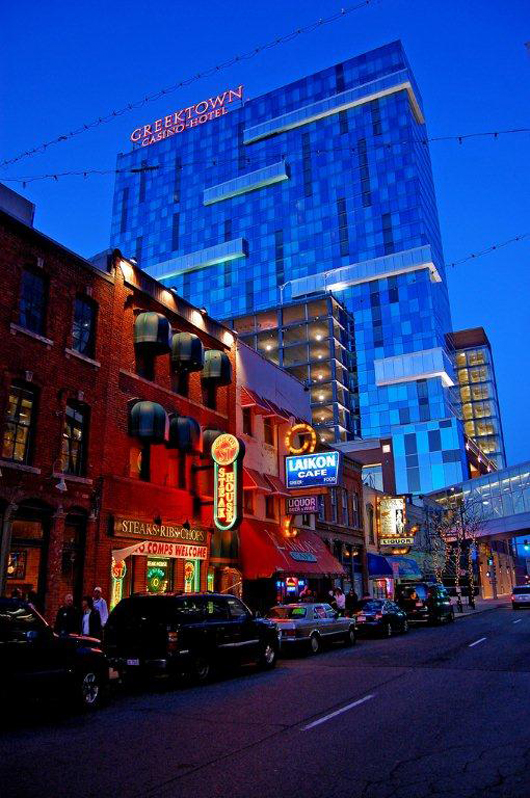
DETROIT (AP) – If everyone’s a little Irish on St. Patrick’s Day, then we’re all part Greek the rest of the year. At least, that’s what they’ll tell you at Detroit’s brand-new Hellenic Museum of Michigan, which will opened its doors to the public Saturday.
“We want to focus on the notion that all who enter the museum are descendants of ancient Hellas,” membership secretary and board member Tony Niarhos tells The Detroit News “whether you’re Greek or not.”
Saturday’s opening festivities, the day before Detroit’s 12th annual Greek Independence Day Parade, will include an official ribbon-cutting at the museum at 5 p.m., followed by a 6:30 p.m. gala reception to benefit the museum at the Detroit Institute of Arts.
Ancient Greece—more properly known as Hellas—is widely credited with gifting democracy and the tradition of free intellectual discourse to the world at large. It’s a cultural legacy as pertinent in Berlin as in Washington, D.C., with its white-marble buildings based on Roman precedents that were themselves modeled on ancient Greek architecture. Democratic government, Western languages, architecture and theater all trace their roots to Hellas.
To celebrate this universal heritage and to remind Metro Detroiters of the Greek-American story, as well, Hellenic museum officials say they hope to attract visitors far beyond the local Greek community, which they estimate numbers about 70,000.
“We’re not just here for Greek community,” says museum vice president for operations Joan De Ronne, “but to help the wider community learn about Hellenism and the history that’s the bedrock of civilization.”
Housed in a 1912 red brick mansion right across East Kirby from the Detroit Institute of Arts, the museum—with a total investment so far of about $2 million raised from foundations and individual donations—will add yet more oomph to the Cultural Center at the north end of Midtown, joining the Charles H. Wright Museum of African American History as the district’s other ethnically focused institution. With eventual plans for exhibits, lectures, films, cooking classes and music and dance performances, the Hellenic Museum will round out weekend entertainment options for the culturally inclined.
That way, when weekend events at other Midtown cultural institutions are mobbed, you can trot over and check out what’s going on at the Hellenic Museum.
The museum is starting small, however, and many of those plans will take shape slowly over the next year. For the foreseeable future, the museum will only be open Saturday afternoons while work, mostly out of sight, continues.
“Keep in mind that this building was vacant for 10 years,” says executive board president Ernest Zachary, whose real-estate development firm is located just a few blocks away. “So we had to put it back together. And we’re still doing that. There were a lot of leaks, buckling floors and cracked plaster.”
Visitors strolling through the galleries, however, are unlikely to be aware of that. The house, with a renovation plan by Elisabeth Knibbe—the same architect who did the Inn on Ferry Street right behind the museum—will feature a first-floor exhibition on the history of Detroit’s Greektown that Wayne State University students compiled, while the wider story of Greek history, complete with a useful timeline from 4,000 B.C. to the present, will be presented in three rooms on the second floor.
Upstairs, don’t miss the dark green, 19th-century wedding dresses in a room devoted partly to examples of the national costume. Downstairs, in addition to its own timeline and historical photographs, the Greektown exhibit will include colorful artifacts such as the actual front door—complete with a bas-relief sculpture of a 19th-century Greek freedom fighter—from the old New Hellas Restaurant on Monroe Street that closed several years ago.
Stephanie Vlahakis, past president of the National Hellenic Museum in Chicago, helped advise the Detroit founders, and tips her hat to their feat in pulling off a new museum in the midst of a down economy. “Tenacious individuals make miracles happen,” she says.
The museum has also benefited from the generosity of its neighbors. The College for Creative Studies sent students over to help with labor, while students at the University of Michigan’s landscape architecture program worked up a plan for the grounds that Zachary says will be implemented. And for the past several months, 12 students from Marilyn Zimmerman’s Art as Activism course at Wayne State University have undertaken much of the archival research to pull together the Greektown exhibit.
Wayne State junior Che-Lin Aldridge, who went through hundreds of historic photos for the museum, sees it all as part of the dizzying ethnic tapestry that comprises the greater Detroit area.
“It’s so interesting how cultures blend together,” she says. “I’m African-American but spent lots of time in Greektown while growing up, whether playing pinball, going to Pegasus or,” she adds with a laugh, “the Golden Fleece for breakfast at 2:30 in the morning.”
___
Information from: The Detroit News, http://detnews.com/
Copyright 2013 Associated Press. All rights reserved. This material may not be published, broadcast, rewritten, or redistributed.
AP-WF-04-12-13 1423GMT
ADDITIONAL IMAGE OF NOTE



